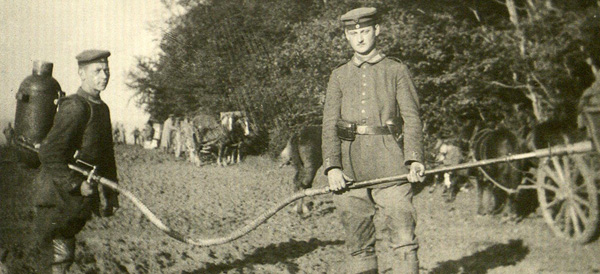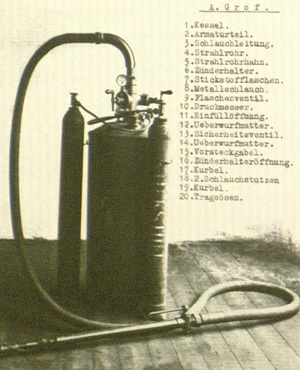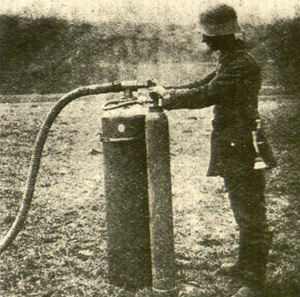 The Soldier at the Western Front – The Use of Flamethrower
The Soldier at the Western Front – The Use of Flamethrower
Source 5: Small flamethrower – Large flamethrower
The small flamethrower (Kleif abbreviated from Kleiner Flammenwerfer) could be carried by a man on his back and was able to produce a stream of flames that reached up to 20 m for 15 seconds. Because of this it was suitable for assaults and the trench warfare. The Kleif M 1912 was the first produced flamethrower. It had no waist belt, so the soldier could free himself of it immediately in case the weapon would ignite itself or it was hit by enemy fire. The weapon was handled by two men – one man took aim with the steel tube while the other handled the valve. During the following years the model was further refined and many innovations have been applied.

Soldiers of the III. garde pioneer bataillon, equipped with the Kleif M.1914
(Thomas Wictor: German flamethrower pioneers of World War I, Atglen 2007, p. 43)
The immobile large Flamethrower (Grof abbreviated from Großer Flammenwerfer) was handled by at least three men. It had separated oil and fuel tanks and was designed like the base model, the portable flamethrower designed by Richard Fiedler. Because of its high weight it was quite immobile and wasn’t suitable for the use in the field. It was mainly used for attack and defense of fortifications and strongholds. The Grof could produce a stream of flames that reached a distance of 45m and that lasted for 45 seconds. Depending on the direction of the wind the conflagration gas reached even farer. At the end of 1916 an enhanced version was introduced. The light Grof was smaller, lighter and with an empty tank it could be carried by one person – with a full one by two.


Grof M.1912 (left) and Light-Grof M.1916, an enhanced version of the large flamethrower (right)
(Thomas Wictor: German flamethrower pioneers of World War I, Atglen 2007, p. 85)
![]() The Soldier at the Western Front – The Use of Flamethrower
The Soldier at the Western Front – The Use of Flamethrower


